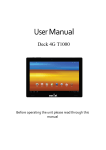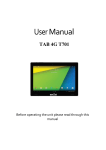Download User Guide for Windows®10
Transcript
E10684 First Edition July 2015 User Guide for Windows® 10 System requirements To facilitate a smoother transition from your previous operating system, read the system requirements below before upgrading to Windows® 10 Processor 1 GHz or faster RAM 1GB (32-bit) or GB (64-bit) Hard disk space 16 GB (32-bit) or 20 GB (64-bit) Graphics card Microsoft DirectX9 (or higher) graphics device with WDDM 1.0 driver Screen resolution 1024 x 600 NOTE: For updates on these system requirements, visit http://www. microsoft.com/en-us/windows/windows-10-faq Icons The icons below indicate the devices you can use for completing a series of tasks or procedures on your ASUS All-in-One PC. = (optional) Use the touch screen panel. = Use the wireless / wired mouse. = Use the wireless / wired keyboard. 1 Starting for the first time When you start your ASUS All-in-One PC for the first time, a series of screens appear to guide you in configuring your Windows® 10 operating system. To start your ASUS All-in-One PC for the first time: 1. Press the power button on your ASUS All-in-One PC. Wait for a few minutes until the setup screen appears. 2. From the setup screen, pick your region and a language to use on your ASUS All-in-One PC. 3. Carefully read the License Terms. Select I accept. 4. Follow the onscreen instructions to configure the following basic items: • Personalize • Get online • Settings • Your account 5. After configuring the basic items, Windows® 10 proceeds to install your apps and preferred settings. Ensure that your ASUS All-inOne PC is kept powered on during the setup process. 6. Once the setup process is complete, the Desktop appears. NOTE: The screenshots in this manual are for reference only. 2 Start menu The Start menu is the main gateway to your ASUS All-in-One PC’s programs, Windows® apps, folders, and settings. Change account settings, lock, or sign out from your account Launch an app from the Start screen Launch an app from the taskbar Launch Taskview Launch Search Launch the Start menu Launch All apps Shut down, restart, or put your ASUS All-in-One PC to sleep Launch Settings Launch File Explorer You can use the Start menu to do these common activities: • Start programs or Windows® apps • Open commonly used programs or Windows® apps • Adjust ASUS All-in-One PC settings • Get help with the Windows operating system • Turn off your ASUS All-in-One PC • Log off from Windows or switch to a different user account 3 Launching the Start menu Tap the Start button in the lower-left corner of your desktop. Position your mouse pointer over the Start button in the lower-left corner of your desktop then click it. Press the Windows logo key on your keyboard. Opening programs from the Start menu One of the most common uses of the Start menu is opening programs installed on your ASUS All-in-One PC. Tap the program to launch it. Position your mouse pointer over the program then click to launch it. Use the arrow keys to browse through the programs. Press to launch it. NOTE: Select All apps at the bottom of the left pane to display a full list of programs and folders on your ASUS All-in-One PC in alphabetical order. 4 Windows® apps These are apps pinned on the right pane of the Start menu and displayed in tiled-format for easy access. NOTE: Some Windows® apps require signing in to your Microsoft account before they are fully launched. 5 Working with Windows® apps Use your ASUS All-in-One PC’s touch screen, touchpad, or keyboard to launch, customize, and close apps. Launching Windows® apps from the Start menu Tap the app to launch it. Position your mouse pointer over the app then click to launch it. Use the arrow keys to browse through the apps. Press to launch an app. Customizing Windows® apps You can move, resize, unpin, or pin apps to the taskbar from the Start menu using the following steps: Moving apps Press and hold the app, then drag and drop it to a new location. Position your mouse pointer over the app, then drag and drop the app to a new location. 6 Resizing apps Press and hold the app, then tap and select an app tile size. Position your mouse pointer over the app and right-click it, then click Resize and select an app tile size. Use the arrow keys to navigate to the app. Press , then select Resize and select an app tile size. Unpinning apps Press and hold the app, then tap the icon. Position your mouse pointer over the app and right-click it, then click Unpin from Start. Use the arrow keys to navigate to the app. Press , then select Unpin from Start. 7 Pinning apps to the taskbar Press and hold the app, then tap Pin to taskbar. Position your mouse pointer over the app and right-click it, then click Pin to taskbar. Use the arrow keys to navigate to the app. Press , then select Pin to taskbar. Pinning more apps to the Start menu From All apps, press and hold the app you want to add to the Start menu, then tap Pin to Start. From All apps, position your mouse pointer over the app you want to add to the Start menu and right-click it, then click Pin to Start. From All apps, press on the app that you want to add to the Start menu, then select Pin to Start. 8 Task view Quickly switch between opened apps and programs using the task view feature, you can also use task view to switch between desktops. Launching task view Tap the icon on the taskbar or swipe form the left edge of the screen. Position your mouse pointer over the icon on the taskbar and click it. Press on your keyboard. 9 Snap feature The Snap feature displays apps side-by-side, allowing you to work or switch between apps. Snap hotspots You can drag and drop apps to these hotspots to snap them into place. 10 Using Snap or 1. Launch the app you wish to snap. 2. Drag the title bar of your app and drop the app to the edge of the screen to snap. 3. Launch another app and repeat the above steps to snap another app. 1. Launch the app you wish to snap. 2. Press and hold the key, then use the arrow keys to snap the app. 3. Launch another app and repeat the above steps to snap another app. 11 Action Center Action Center consolidates notifications from apps and presents a single place where you can interact with them. It also has a really useful Quick Actions section at the bottom. Launching Action Center Click the icon on the taskbar or swipe from the right edge of the screen. Position your mouse pointer over the taskbar and click it. Press 12 on your keyboard. icon on the Other keyboard shortcuts Using the keyboard, you can also use the following shortcuts to help you launch applications and navigate Windows® 10. \ Launches Start menu Launches Action Center Launches the desktop Launches the File Explorer Opens the Share panel Launches Settings Launches Connect panel Activates the Lock screen Minimizes all currently active windows 13 Launches Search Launches Project panel Opens the Run window Opens Ease of Access Center Opens the context menu of the Start button Launches the magnifier icon and zooms in your screen Zooms out your screen Opens Narrator Settings 14 Connecting to wireless networks Wi-Fi Access emails, surf the Internet, and share applications via social networking sites using your ASUS All-in-One PC’s Wi-Fi connection. Connecting Wi-Fi Connect your ASUS All-in-One PC to a Wi-Fi network by using the following steps: or 1. Select the icon from the taskbar. 2. Select the icon to enable Wi-Fi. 3. Select an access point from the list of available Wi-Fi connections. 4.Select Connect to start the network connection. NOTE: You may be prompted to enter a security key to activate the Wi-Fi connection. 15 Bluetooth Use Bluetooth to facilitate wireless data transfers with other Bluetoothenabled devices. Pairing with other Bluetooth-enabled devices You need to pair your ASUS All-in-One PC with other Bluetooth-enabled devices to enable data transfers. Connect your devices by using the following steps: 1.Launch Settings from the Start menu. or 2.Select Devices, then select Bluetooth to search for Bluetooth-enabled devices. 3. Select a device from the list. Compare the passcode on your ASUS All-in-One PC with the passcode sent to your chosen device. If they are the same, select Yes to successfully pair your ASUS All-in-One PC with the device. NOTE: For some bluetooth-enabled devices, you may be prompted to key in the passcode of your ASUS All-in-One PC. 16 Connecting to wired networks You can also connect to wired networks, such as local area networks and broadband Internet connection, using your ASUS All-in-One PC’s LAN port. NOTE: Contact your Internet Service Provider (ISP) for details or your network administrator for assistance in setting up your Internet connection. To configure your settings, refer to the following procedures. IMPORTANT! Ensure that a network cable is connected between your ASUS All-in-One PC’s LAN port and a local area network before performing the following actions. Configuring a dynamic IP/PPPoE network connection 1.Launch Settings. 2.Select Network & Internet. or 3.Select Ethernet > Network and Sharing Center. 4. Select your LAN then select Properties. 5.Select Internet Protocol Version 4(TCP/IPv4) then select Properties. 6.Select Obtain an IP address automatically then select OK. NOTE: Proceed to the next steps if you are using PPPoE connection. 17 Return to the Network and Sharing Center window then select Set up a new connection or network. 7. 8.Select Connect to the Internet then select Next. 9.Select Broadband (PPPoE). 10. Type your User name, Password, and Connection name then select Connect. 11.Select Close to finish the configuration. 12.Select on the taskbar then select the connection you just created. 13. Type your user name and password then select Connect to start connecting to the Internet. Configuring a static IP network connection 1. or 18 Repeat steps 1 to 5 under Configuring a dynamic IP/PPPoE network connection. 2Select Use the following IP address. 3. Type the IP address, Subnet mask and Default gateway from your service provider. 4. If needed, you can also type the preferred DNS server address and alternate DNS server address then select OK. Turning your ASUS All-in-One PC off You can turn off your ASUS All-in-One PC by doing either of the following procedures: or • Launch the Start menu, then select Shut down to do a normal shutdown. • From the log-in screen, select • Press > > Shut down. to launch Shut Down Windows. Select Shut Down from the dropdown list then select OK. • If your ASUS All-in-One PC is unresponsive, press and hold the power button for at least four (4) seconds until your ASUS All-in-One PC turns off. 19 Putting your ASUS All-in-One PC to sleep To put your ASUS All-in-One PC to Sleep mode: or • Launch the Start menu, then select > Sleep to put your ASUS All-in-One PC to sleep. • From the log-in screen, select Press > Sleep. to launch Shut Down Windows. Select Sleep from the drop-down list then select OK. NOTE: You can also put your ASUS All-in-One PC to Sleep mode by pressing the power button once. 20 Entering the BIOS Setup BIOS (Basic Input and Output System) stores system hardware settings that are needed for system startup in the ASUS All-in-One PC. In normal circumstances, the default BIOS settings apply to most conditions to ensure optimal performance. Do not change the default BIOS settings except in the following circumstances: • An error message appears on the screen during the system bootup and requests you to run the BIOS Setup. • You have installed a new system component that requires further BIOS settings or update. WARNING! Inappropriate BIOS settings may result to instability or boot failure. We strongly recommend that you change the BIOS settings only with the help of a trained service personnel. Quickly enter the BIOS To access the BIOS: • When your ASUS All-in-One PC is off, press the power button for at least four (4) seconds to access the BIOS directly. • Press the power button to turn on your ASUS All-in-One PC then press <F2> or <Del> during POST. NOTE: POST (Power-On Self-Test) is a series of software controlled diagnostic tests that run when you turn on your ASUS All-in-One PC. 21 Recovering your system Using recovery options on your ASUS All-in-One PC allows you to restore the system to its original state or simply refresh its settings to help improve performance. IMPORTANT! • Backup all your data files before doing any recovery option on your ASUS All-in-One PC. • Note down important customized settings such as network settings, user names, and passwords to avoid data loss. • Ensure that your ASUS All-in-One PC is plugged in to a power source before resetting your system. Windows® 10 allows you to do any of the following recovery options: • Keep my files - This option allows you refresh your ASUS All-inOne PC without affecting personal files (photos, music, videos, documents). Using this option, you can restore your ASUS All-in-One PC to its default settings and delete other installed apps. • Remove everything - This option resets your ASUS All-in-One PC to its factory settings. You must backup your data before doing this option. 22 • Go back to an earlier build - This option allows you to go back to an earlier build. Use this option if this build is not working for you. • Advanced startup - Using this option allows you to perform other advanced recovery options on your ASUS All-in-One PC such as: - Using a USB drive, network connection or Windows recovery DVD to startup your ASUS All-in-One PC. -Using Troubleshoot to enable any of these advanced recovery options: System Restore, System Image Recovery, Startup Repair, Command Prompt, UEFI Firmware Settings, and Startup Settings. Performing a recovery option Refer to the following steps if you want to access and use any of the available recovery options for your ASUS All-in-One PC. 1.Launch Settings and select Update and security. 23 2. 24 Under the Update and security option, select Recovery then select the recovery option you would like to perform. Using touch screen panel gestures (on selected models) NOTE: The following screenshots are for reference only. The touch screen panel’s appearance may vary depending on model. The gestures allow you to launch programs and access the settings of your ASUS All-in-One PC. The functions can be activated by using the hand gestures on your ASUS All-in-One PC’s touch screen panel. Left edge swipe Right edge swipe Swipe from the left edge of the screen to launch Task view. Swipe from the right edge of the screen to launch Action Center. 25 Tap/Double-tap Press and hold • Tap an app to select it. • Double-tap an app to launch it. Press and hold to open the rightclick menu. Zoom in Zoom out Spread apart your two fingers on the touch screen panel. Bring together your two fingers on the touch screen panel. 26 Finger slide Drag Slide your finger to scroll up and down and slide your finger to pan the screen left or right. • Drag to create a selection box around multiple items. • Drag and drop an item to move it to a new location. 27 Note: Download the multi-language versions of this user manual from the ASUS Support site at http://support. asus.com







































